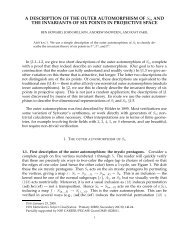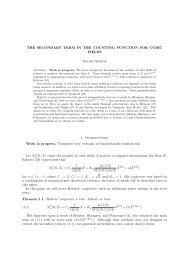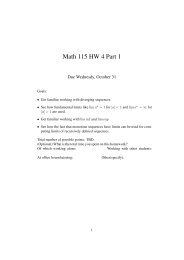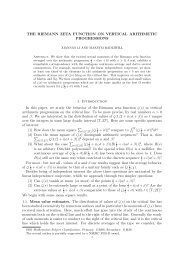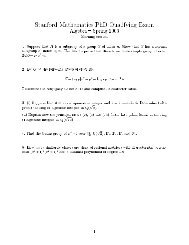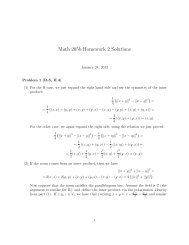Traveling Wave Solutions in a Reaction-Diffusion Model for Criminal ...
Traveling Wave Solutions in a Reaction-Diffusion Model for Criminal ...
Traveling Wave Solutions in a Reaction-Diffusion Model for Criminal ...
Create successful ePaper yourself
Turn your PDF publications into a flip-book with our unique Google optimized e-Paper software.
Step 2 (Subsolution):<br />
M to v−<br />
The case when x > 0 is trivial thus assume that x ≤ 0. Apply<strong>in</strong>g<br />
<br />
(−c + ξ ′ )(ψ ′ (y+) − ψ<br />
Mv− =<br />
′ (y−)) − ψ ′′ (y+) + ψ ′′ (y−) + ψ(y+) − ψ(y−) − α(φ(y+) − φ(y−))<br />
(−c + ξ ′ )(φ ′ (y+) − φ ′ (y−)) − g(ψ(y+) − ψ(y−)) + φ(y+) − φ(y−)<br />
<br />
(16) ξ ′ (ψ ′ (y+) − ψ<br />
=<br />
′ (y−))<br />
ξ ′ (φ ′ (y+) − φ ′ (y−)) + g(ψ(y+)) − g(ψ(y−)) − g(ψ(y+) − ψ(y−)).<br />
Observe that y+ ≤ y− as x < 0 and y− ≥ 0 because x ≤ 0. There are two possibilities we need<br />
to consider, y+ ≤ 0 and y+ ≥ 0. In the latter case, both ψ(y+) and ψ(y−) are bounded above<br />
by s0<br />
2 . First, this implies that ψ′ (y+) − ψ ′ (y−) ≤ 0 and φ ′ (y+) − φ ′ (y−) ≤ 0. Second, it implies<br />
that g(ψ(y+)) − g(ψ(y−)) − g(ψ(y+) − ψ(y−)) = 0; hence, <strong>in</strong> this case Mv− ≤ 0. We are left to<br />
consider the case when y+ ≤ 0, which we work out next (once aga<strong>in</strong> us<strong>in</strong>g (41))<br />
<br />
Me<br />
Mv− ≤<br />
λ(ct+ξ)<br />
<br />
−˜ δe µy+<br />
<br />
−λy− + ˜γe := I<br />
Rewrite the first term<br />
Me λ(ct+ξ) (− ˜ δe µy+ + ˜γe −λy− ) + Lψ(y−)(ψ(y+) − ψ(y−)) := II.<br />
I = −Me λ(x+ct+ξ) ˜ δe µ(−ct+ξ)+x(µ−λ) − ˜γe −λ(−ct+ξ) <br />
≤ −Me λ(x+ct+ξ) ˜ δe µ(−ct+ξ) − ˜γe −λ(−ct+ξ) <br />
.<br />
There<strong>for</strong>e, if t < −T1, replace T1 by a larger value if necessary, then<br />
˜δe µ(−ct+ξ(t)) − ˜γe −λ(−ct+ξ(t)) ≥ 0 <strong>for</strong> t ∈ (−∞, −T1] (44)<br />
because λ > µ. For the second term we use the bound<br />
which gives,<br />
Lψ(y−)(ψ(y+) − ψ(y−)) ≤ Lδe −λy− ,<br />
II ≤ −Me λ(x+ct+ξ) ( ˜ δe µ(−ct+ξ) − ˜γe −λ(−ct+ξ) − Lδe −λ(−ct+ξ) )<br />
≤ 0,<br />
provided T1 is chosen negative enough to satisfy<br />
˜δe µ(−ct+ξ) − ˜γe −λ(−ct+ξ) − Lδe −λ(−ct+ξ) ≥ 0 <strong>for</strong>t ∈ (−∞, −T1]<br />
(with T1 replaced by its updated value).<br />
Step 3 (Entire Solution): Let n be a positive <strong>in</strong>teger and (sn(x, t), un(x, t)) be the solutions<br />
to (8) <strong>for</strong> x ∈ (−∞, ∞) and t ∈ (−n, ∞) with <strong>in</strong>itial data<br />
sn(x, −n) = w−(x, −n), un(x, −n) = v−(x, −n).<br />
From the def<strong>in</strong>itions of v+, v−, see (39) and (40), respectively, we see that<br />
w−(x, −n) ≤ sn(x, −n) ≤ w+(x, −n) and v−(x, −n) ≤ vn(x, −n) ≤ v+(x, −n)<br />
By the comparison pr<strong>in</strong>ciple<br />
w−(x, t) ≤ sn(x, t) ≤ w+(x, t), v−(x, t) ≤ un(x, t) ≤ v+(x, t) <strong>for</strong> (x, t) ∈ R × (−n, −T1). (45)<br />
14



